Spatial and temporal evolution of electromagnetic pulses generated at Shenguang-II series laser facilities
Qiangyou HE (何强友), Ning KANG (康宁), Lei REN (任磊), Chao TIAN(田超), Chuanke WANG (王传珂), Zhimeng ZHANG (张智猛),Dongxiao LIU (刘东晓), Lei YANG (杨雷), Huiya LIU (刘会亚),Mingying SUN(孙明营),Baoqiang ZHU(朱宝强),Weimin ZHOU(周维民),∗and Tingshuai LI (李廷帅)
1 School of Materials and Energy, University of Electronic Science and Technology of China, Chengdu 611731, People’s Republic of China
2 National Laboratory on High Power Laser and Physics,Shanghai Institute of Optics and Fine Mechanics,Chinese Academy of Sciences, Shanghai 201800, People’s Republic of China
3 Laser fusion research center, Chinese Academy of Engineering Physics, Mianyang 621900, People’s Republic of China
4 Qiangyou HE and Ning KANG contribute equally to this work.
Abstract The distribution and sources of EMPs produced at Shenguang-II(SG-II)series laser facilities are systematically investigated.The results indicate that the EMP amplitudes in the SG-II ps PW laser are very strong,one order higher than those from the SG-II laser facility.EMPs outside the target chamber decrease exponentially with the distance from the measuring points to the target chamber center at the two laser facilities.Moreover,EMPs can be remarkably reduced when the picosecond laser together with the nanosecond laser is incident to targets compared to the SG-II ps PW laser alone.The resulting conclusions are expected to offer experimental supports for further effective EMPs shielding design and achievement in high-power laser facilities.
Keywords: laser, electromagnetic pulse, target, intensity
1.Introduction
To gain insights into the generation and mitigation of EMPs is significant for the safe and reliable execution of experiments.During the interaction of high-power laser with solid targets,electron [1], ion [2], x-ray [3] and EMPs are simultaneously generated.It was reported that the spectra of these EMPs extended from several tens of MHz to THz [4–6], and EMP amplitude could reach up to hundreds of kV m−1and even MV m−1[7].The extremely strong EMPs could interfere with various physical diagnostics in laser-plasma experiments and even cause the malfunction of some setups [8].
In 1978, EMPs with wideband frequencies from radio frequency (RF) to microwave stemming from the laser-target interactions were firstly recorded [9].To gain more understandings of the characteristics and mitigation of EMPs,substantial efforts have been made at the National Ignition Facility (NIF) and Titan laser facility [10], where EMPs reached as high as 10 kV m−1and the frequency ranged from 100 MHz to 5 GHz.EMPs at Titan were lifted to hundreds of kV m−1with a lifetime of ∼400 ns before decaying into noise, whose frequency domains were also much broader.Although possible grounding and shielding protection for the diagnostic setups at OMEGA were designed to eliminate detrimental effects of EMPs [6], only some preliminary attempts could be carried out for removing EMPs before the mechanisms of EMPs generation were thoroughly unraveled.
Afterwards, several models were developed to interpret the laser-driven EMPs with multiple peaks.Dubois et al built a comprehensive model based on target electric polarization,which revealed that EMPs mainly resulted from the hot electrons emitting from targets [11], and then magnetic field dipolar emission based on the target-holder-ground equivalent antenna was proposed [4, 5], which theoretically confirmed that the target current was also a crucial source of EMPs.The target current probe (T-probe) at the PALS Research Infrastructure was designed and calibrated to verify the established models [12, 13].Meanwhile, the correlations between the return target current and EMP emissions were discussed,which indicated that the energy of EMP deposited on the loop antenna was proportional to the maximum value of the target current.Besides, the low-frequency EMPs (LFC) induced by the target current were experimentally identified [14].Moreover, there are other EMP sources in laser-target interaction,such as charged layers due to photoionization, wakefields of accelerated charges, and some other charged particles at surfaces [15].
Accordingly, investigations into the possible factors that determine EMPs are conducted,including target configuration and materials[16–22],laser power and pulse duration[16–18,23], target stalk geometry [16, 18], etc which laid solid experimental basis for the shielding of EMPs.However,most previous reports mainly focus on the features of EMPs inside the target chamber, while the amplitude and distribution of EMPs outside the target chamber remain unexplored to date,although it is significant for the protection of electronic devices surrounding the target chamber.In this study,starting from the experiments carried out at the SG-II and SG-II UP laser facilities, the distribution and possible sources of EMPs at the two laser facilities are systematically studied and deep mechanisms are proposed and analyzed.
2.Experimental arrangements
Measurement of EMPs was performed at SG-II laser facilities at the National Laboratory on High-Power Laser and Physics(NLHPLP).As schematically shown in figure 1, the building for this facility has three floors and the EMP probes were placed in three regions, where the blue, red and green dots represent layers −1, +1, and +2 floors of the laser building.EMP measurements were separated into four zones including Target Area for SG-II (Z1),Laser Bay for SG-II(Z2),Target Area for SG-II UP and ps PW(Z3), and Laser Bay for SG-II UP and ps PW (Z4).We tested the spatial characteristics of EMPs at two laser modes called SG-II (ns) and SG-II Ps PW(ps).In Z1 and Z2, EMPs produced by the interaction between SG-II laser and target were measured.The distance between different probe locations and SG-II target chamber center(TCC)is shown in figure 1.In zone Z3 and Z4,EMPs are mainly produced by SG-II ps PW laser.The distance between different probe locations and SG-II TCC is also presented.
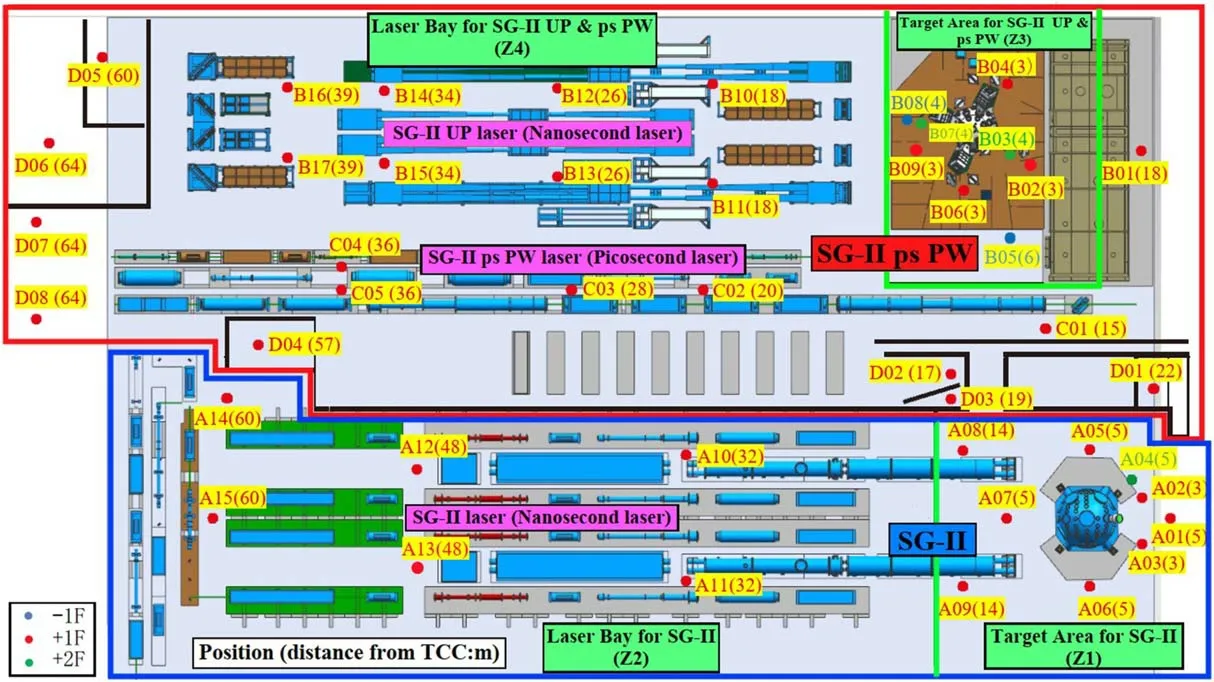
Figure 1.Schematic top view of EMPs measuring points at SG-Ⅱseries laser facilities.The blue,red,and green dots represent the measuring points at −1,+1,and+2 floors of the laser building.The number in parentheses next to probe id number corresponds to the distance from TCC in meters.
The SG-II target chamber is a steel spherical chamber with a radius of 0.8 m.The SG-II laser has eight beams that deliver nanosecond pulses (North: N1, N2, N3, N4; South:S1, S2, S3, and S4) [24].SG-II laser (1.8 kJ, 1 ns,λ = 351 nm) was focused on the CD plane target with a thickness of 10 μm.The FWHM diameter of the laser focal spot is 300 μm and the corresponding laser intensity is 1.25 × 1015W cm−2.The SG-II UP and ps PW target chamber is an aluminum alloy spherical chamber with a radius of 1.2 m.The SG-II ps PW laser includes one picosecond laser beam.The SG-II ps PW laser (320 J, 1 ps,λ = 1053 nm) was incident on the aluminum foil target with the same thickness and a focal spot of 50 μm FWHM in diameter.The intensity of SG-II ps PW laser is 0.8 × 1019W cm−2.The pre-pulse to main pulse intensity contrast ratio is 10−8for SG-II ps PW laser.
The planar microstrip super-wideband (SWB) antenna(0.8–18 GHz) was used to monitor and record EMPs in this study [25].The antenna was connected with 20 m doubleshielded (90 dB) SMA coaxial cables to an oscilloscope(Tektronix DPO 70604C with a 6 GHz analog bandwidth and a 25 GS s−1sampling rate).The oscilloscope was placed in a Faraday cage to avoid the direct coupling of EMP to the oscilloscope, which could achieve pure EMP signals [26].Moreover,to protect the oscilloscope due to overload voltage,suitable attenuators were installed between the coaxial cables and the oscilloscope.
3.Results and discussion
Variation of the maximum amplitudes of the EMP signals with the distance from TCC is presented in figure 2.The results indicate that EMP produced at SG-II series laser facility is strongly related to the laser modes and the distance from the TCC.Firstly, EMPs induced by SG-II ps PW laser are one order intense than that of SG-II laser with the same distance from TCC, in consistence with some previous reports:EMPs with a much larger amplitude can be generated by intense ps laser facilities than ns laser facilities [10, 27],which may be attributed to the higher laser intensity of the SG-II ps PW laser (0.8 × 1019W cm−2) compared with the SG-II laser (1.25 × 1015W cm−2), supported by the conclusion that the EMP amplitude increased with the laser intensity according to the PIC simulations and experimental results,the energy and number of escaping hot electrons increased when the laser intensity was enhanced, which indirectly led to the increase of EMP amplitude [17].Moreover, EMP amplitude was found to linearly depend on the laser intensity at the 200 TW laser system (VEGA 2) [28].

Figure 2.Evolution of the maximum amplitude of the EMP signal with the distance from TCC at different laser modes.
For SG-II or SG-II UP laser,The EMP amplitude outside the target chamber decreases exponentially with the distance from the TCC,which may attribute to the propagating loss of electromagnetic waves.The EMP amplitude was approximately proportional to1r2/ when electromagnetic waves propagated inside the target chamber (vacuum) [10], where r was the distance from the measuring location to the TCC.Compared to the electromagnetic wave proceeding inside the target chamber, there are many objects outside the target chamber such as laser facility diagnostic devices and concrete walls that can adsorb or scatter EMPs, so EMP outside the target chamber will degrade at a much faster rate [29],which can be verified by the multiple shielding layers of 0.5 mm PTFE, 0.4 mm copper film and 2.4 mm lead [30] that attenuate EMP amplitude over 448 times.
To get a more comprehensive evaluation of EMPs at SGII series laser facility, the dependence of EMP energy on distance by SWB antennas is given in figure 3 [31].It is evident that the interaction between SG-II ps PW laser and solid target produces three orders stronger EMP than that between SG-II laser and target.As shown in figures 2 and 3,EMP amplitude and energy at Z2 and Z4 with the same distance from TCC are of great difference, which is mainly affected by the EMP sources at Z2 and Z4.The typical timedomain waveforms are presented in figure 4(a).

Figure 3.Dependence of EMP energy on the distance from TCC at different laser modes.
According to figure 4(a),EMPs at Z1 and Z3 have multipeaked features with a duration of several hundred nanoseconds.However, EMPs at Z2 and Z4 show clustered peaks and a longer duration of several thousand nanoseconds.The absolute values of the discrete Fourier transform of EMPs(0.8–3 GHz) measured at four regions are shown in figure 4(b), where the frequencies of EMPs at Z2 and Z4 mainly range from 0.8 to 1.14 GHz, but EMPs at Z1 and Z3 have broader frequency domains from 0.8 to 1.61 GHz.In short, there are obvious discrepancies between the timedomain waveforms and absolute values of the discrete Fourier transform of EMPs of the target area and laser bay at SG-II series laser facilities.We herein strongly speculate that the measured signals also include electromagnetic waves generated by experimental apparatuses and cables at Z2 and Z4,implying that laser-target interaction is not the sole source of EMP signals for Z2 and Z4 and the coupling of EMP signals alters frequency distributions.EMPs at the National Ignition Facility were also reported to have multiple peaks and longer duration which stemmed from the second sources of EMPs generated by diagnostics on NIF [32].All the results provide a solid basis for electromagnetic shielding design in different zones of SG-II series laser facilities.

Figure 4.(a) Time-domain waveforms and (b) absolute values of the discrete Fourier transform of EMPs measured at four regions.
Interestingly, we also found a significant decrease of the EMP amplitude for the case with SG-II UP and ps PW(ns and ps)laser compared to the case with the SG-II ps PW(ps)laser alone in this experiment.Although the characteristics of EMPs generated by different modes of laser shooting targets are revealed [23, 31, 33], there are two targets (ns target and ps target)and two laser modes of SG-II UP(ns laser)and SGII ps PW (ps laser) in our experiment as listed in table 1.

Table 1.Detailed information of shots for SG-II ps PW (ps) and SG-II UP and Ps PW (ns and ps).
To gain more insights into the effects of laser pulse on EMPs, we studied and compared the EMPs generated by the SG-II ps PW(ps alone)and SG-II UP and ps PW(ns and ps)laser.The experimental arrangement and schematic diagram are demonstrated in figure 5.There are two alternative targets in this experiment.The nanosecond target is a CH double shell target made of polystyrene with a thickness of 70 μm and an outer radius of 270 μm.The picosecond target is an Au wire with a diameter of 20 μm and a length of 500 μm.The CH double shell target and Au wire are mounted on top of a cylindrical copper stalk with a diameter of 3 mm and a length of 5 cm.The distance between CH double shell target and Au wire is 10 mm.
The experimental process can be divided into the following two steps.Firstly,the SG-II UP(λ= 351 nm)laser is focused on the CH double shell target (ns target).After a pulse delay of 2.2 ns,the SG-II ps PW(λ= 1053 nm)laser is incident on the Au wire (ps target).The corresponding laser and target parameters are presented in table 1.The probe was placed at B09(3 m from the TCC of SG-II UP and ps PW).A deflecting magnetic field of a 2000 G electron spectrometer was used to quantify electrons with different energy.
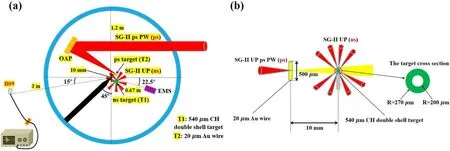
Figure 5.(a)Schematic layout of the experimental arrangement,(b)schematic diagram of the interaction between SG-II UP and ps PW laser and targets.
In figure 6(a),the maximum value of EMPs generated by SG-II ps PW laser reaches 18.4 V, but it is reduced to 0.4 V for the EMPs induced by SG-II UP and ps PW.The EMP amplitude stemming from SG-II UP and ps PW is 46 times smaller than SG-II ps PW alone.In figure 6(b), the frequencies of EMPs corresponding to SG-II ps PW mainly range from 0.8 to 2.31 GHz with a typical peak at 1.5 GHz.Moreover, EMPs at SG-II UP and ps PW have a frequency range from 0.8 to 2.43 GHz with a typical peak of nearly 1 GHz.
To study the temporal evolution of EMPs spectrum, a time-frequency analysis by means of the short-time Fourier transform was applied for signals as shown in figure 6(a)[7].The time-dependent spectrograms of EMPs are presented in figure 7.The detailed information of frequency peaks is given in table 2, where the frequency of EMP generated by SG-II UP and ps PW beyond 1.07 GHz is strongly attenuated compared to SG-II ps PW.
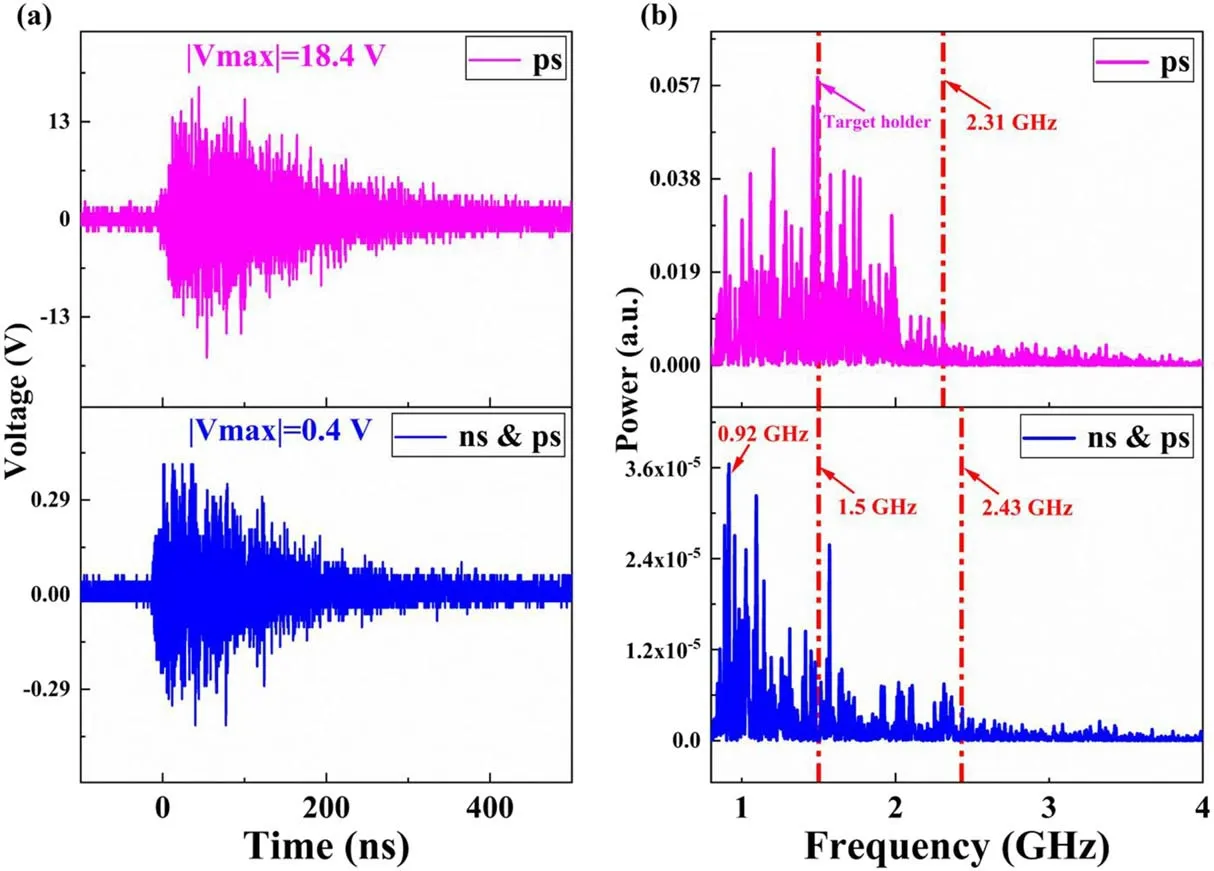
Figure 6.(a)The original EMP signals and(b)the corresponding absolute values of discrete Fourier transform of EMPs generated by SG-II ps PW (ps) and SG-II UP and ps PW (ns and ps).

Figure 7.Time-dependent spectrograms of EMPs generated by SG-II ps PW (ns) and SG-II UP and ps PW (ns and ps).
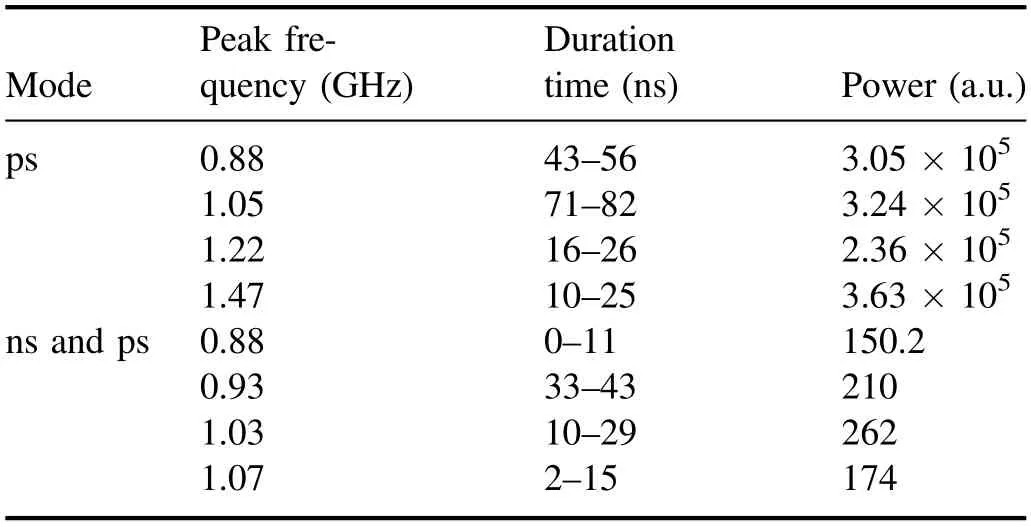
Table 2.Detailed information of frequency peaks for time-dependent spectrograms of EMPs.
There are two typical frequencies of RF emissions for laser-target interaction.The first fundamental frequencyfpdis related to laser pulse durationτ[19] as expressed in equation (1)

For SG-II ps PW, the laser pulse duration is 20.92 ps,fpd≅11.95 GHz.For SG-II UP and ps PW,the laser pulse duration of SG-II UP is 2.5 ns,100 MHz.The laser pulse duration of SG-II ps PW is 15.82 ps,15.8 GHz.However, these fundamental frequencies cannot be observed in figures 5(b) and 6 because of the limitation of SWB antenna bandwidth (0.8–18 GHz) and oscilloscope(0–6 GHz).
The second fundamental frequencyfais determined by the neutralization current.Meanwhile,the target holder acts as a quarter-wavelength dipole antenna and the metallic ground as a mirror [4, 5]

where c is the light speed in vacuum andlhis the length of the target holder.In this experiment, the length of the target holder is 5 cm,1.5 GHz.The fundamental frequencyfais identifiable in the spectra of EMP generated by SG-II ps PW(ps) as shown in figures 5(b) and 6.However, the fundamental frequencyfais strongly attenuated when SG-II UP and ps PW (ns and ps) laser couples with targets.
On the other hand, EMP signals produced by ns and ps are closely related to the time delay between ns laser and ps laser[34].The EMP signal only originates ns laser interaction when the time delays are smaller than 20 ns.However, the EMP level is same to the one measured in ps laser interaction when the time delay is longer, which is possible because the hot electrons emitted from the ns target accumulate on the ps target and negatively charge it and the plasma environment created with the x-ray emission suppresses the EMP emission from the ps laser interaction.
Previously, we confirmed that EMPs were intimately related to hot electrons ejected from the plasma based on experimental results and theoretical analysis [22].As displayed in figure 5, compared to the SG-II ps PW (ps) lasertarget interaction,we did observe a significant reduction in the number and energy of hot electrons generated by SG-II UP and ps PW (ns and ps) laser-target interaction.The corresponding electron energy spectra are presented in figure 8.

Figure 8.The electron energy spectra generated by SG-II ps PW and SG-II UP and ps PW.
We believe that the decrease of EMP amplitude generated by SG-II UP and ps PW laser interaction can be attributed to the decrease of the number and the energy of hot electrons emitting from the picosecond target.Fewer electron escapes from the picosecond target, resulting in a lower potential difference between the ground and target and a smaller neutralization current, which eventually leads to the strong suppression of EMPs due to SG-II UP and ps PW laser interaction [4, 18, 23].However, the physical mechanism for the decrease of the number and the energy of hot electrons is not fully understood, which may be related to the energy transmission efficiency from SG-II ps PW laser to hot electrons [35].We will further investigate this phenomenon in subsequent experiments, which can provide a new idea for EMP control on high-power laser facilities.
4.Conclusions
The characteristics of EMPs at SG-II series laser facilities have been investigated using planar microstrip SWB antennas.EMP amplitude of both SG-II and SG-II ps PW lasers outside the target chamber was generally fitted an exponential decay function of the distances from TCC.Moreover,the SGII ps PW laser interacting with targets emitted more intense EMPs than the SG-II laser due to the huge deviation in the laser intensity for SG-II (ns) and SG-II ps PW (ps) laser.Besides, SG-II UP and ps PW (ns and ps) laser significantly reduces the EMP amplitude.Some other EMP radiation sources in addition to the laser-target interaction in SG-II facility and SG-II UP and ps PW facility are found.
Acknowledgments
We are grateful to the support of all the technical staff of the SG-II series laser facilities in experiments.This work was supported by the Strategic Priority Research Program of the Chinese Academy of Sciences (No.XDA25020205) and Shanghai Science and Technology Development Funds (No.20692114101).
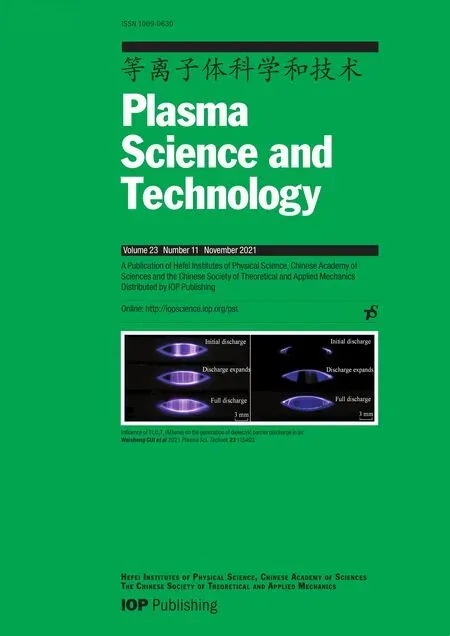 Plasma Science and Technology2021年11期
Plasma Science and Technology2021年11期
- Plasma Science and Technology的其它文章
- Numerical study on the loss of fast ions produced by minority ion cyclotron resonance heating in EAST
- Machine learning of turbulent transport in fusion plasmas with neural network
- Observation of coherent mode induced by a molybdenum dust on EAST
- Investigation of stimulated Raman scattering in longitudinal magnetized plasma by theory and kinetic simulation
- The influence of magnetic field on the beam quality of relativistic electron beam long-range propagation in near-Earth environment
- Regulation of the density distribution of a strongly dissipative plasma by a pulsed magnetic field
